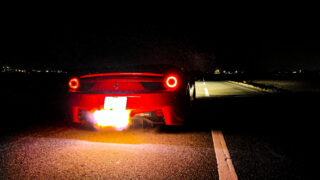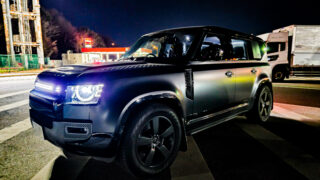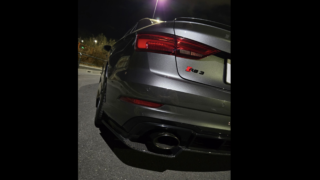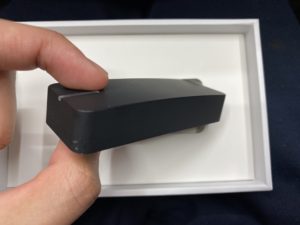学生なら物理で車を考える②【コーナリング編】
首都高と峠でを速く走るにはコーナーをいかに攻められるかということ。私がどのようにしてコーナーを速く曲がる練習をしたかお教えします。
遠心力
まずコーナーを攻めるのはドライ路面だけにしましょう。ウェットは限界が読めない面もあるのでふとした瞬間スーッと流されます。
力は質量×加速度です。遠心力も”質量”と曲がっている方向とは逆向きの”加速度”の積で働きます。
そしてその加速度はカーブの半径と速度に依存します。高速道路で「R=300」とか書いてある標識見たことありませんか?あれは「このカーブは半径300mの円と同じ曲がり具合ですよ」という意味です。カーブの半径をr[m]、速度をv[m/s]とすると加速度aは次の通りです。
$$a=\frac{v^2}{r} [m/s^2]$$遠心力は「速度の二乗に比例」「半径に反比例」します。
例えばあるコーナーをいつも50km/hで曲がっている時、横Gが0.2Gだとしたら、速度が2倍の100km/hで曲がったら横Gは4倍の0.8Gになります。
また半径100mのカーブをある一定の速度で曲がった時の横Gが0.6Gだとした時、半径200mのカーブを同じ速度で曲がると横Gは0.3Gになります。
Gの定義
「Gを感じる〜」とかカーロケに表示されるG、ドラレコの衝撃時録画の衝撃度合いの設定で登場するGなど色々なGがあります。物理学で正確に表される数値としては「〇〇×9.8」を計算した値になり、Gまたはgはある決まった定数であります。
重力にも地面の向きに1Gの加速度が働いており、重力加速度と言います。この重力加速度がGの基準であり、例えばコーナリングで横Gが1.00発生した時は、重力と同じ分の遠心力が発生したことになるわけです。運転していて真横に重力と同じ分の力が発生したらびっくりしますよね。横に1.0Gを発生させるようなコーナリングはそれくらいおっかないということです。
Gを知って練習する
履いているタイヤや車の種類によって限界Gは左右します。私は下の写真のようなGセンサー付きカーロケを車につけております。

こういう加速度センサーを持っていないとイメージが湧かないと思うので例を挙げると、
- 普通のブレーキ:0.1Gから0.2G
- 下手なブレーキ、強いブレーキ:0.3Gから0.5G
- 急ブレーキ、フルブレーキ:0.6Gから1.0Gまたはそれ以上
- 緩やかなカーブ:0.1Gから0.3G
- ちょっと急カーブ、急ハンドル:0.4Gから0.5G
- 首都高、峠で攻める:0.6G以上
- タイヤが鳴り出す:0.8G以上
- アイスバーンでのフルブレーキ:0.1G
- 雪上でのフルブレーキ:〜0.3G
- ウェット路面でのフルブレーキ:0.6Gから0.7G
- ドライ路面でのフルブレーキ:0.7G後半
私は実際に加速度センサーを見ながら走ってみたり、速い車の後をついていって加速度メーターを見ながら曲がったりしながら練習してきました。
いつも使う道のカーブの半径は当然変わりませんよね。自分が何キロで走るかによって遠心力は左右することを頭に入れてきました。いつも100km/hで曲がっているところが0.5Gだから、110km/hなら0.6Gくらいだなって思いながらどんどん限界に近づけていきました。
コーナリングの練習はスピードが出やすい高速道路の方が楽なんですよね。峠とか急なカーブだと、50km/hが70km/hになっただけで横Gは1.4×1.4で1.96倍の約2倍になるのに対し、高速道路で100km/hが120km/hになっても横Gは1.44倍にしかなりません。同じ2倍になるのは200km/hで曲がった時だけ。
峠を限界で曲がっていてちょっとでも限界オーバーな速度で走るとすぐグリップを失いますから危険なのに対し、高速道路なら音を鳴らそうとまでは思わないし、10km/hスピードがアップしただけでもそんなに遠心力は強くなりません。タイヤがなる前にビビってそれ以上出せなくなるだけです。マージンもあるから大丈夫です!
- フェラーリF8 フルストレート バブリング OPFカット施工 ECU書き換え

- ミニ・クーパーS R56 ECUチューニング&バブリング施工

- フェラーリ458 バブリング アフターファイヤー リミッター解除 ECU書き換え施工!

- ランドローバー ディフェンダー V8 ECUチューニング&バブリング施工

- 国内初 レクサスRCF ECUチューニング リミッターカット バブリング施工しました!

- トヨタ 6型ハイエース ディーゼル ECUチューニング スピードリミッター解除 EGRオフ 施工

- ベンツG55 AMG ECUチューニング&バブリング仕様!5.4L V8スーパーチャージャー

- 次世代ECUチューニング AMG GLC63(s) ステージ1.5+バブリング施工仕様

- ワールドモーター服部 | ベンツCLA45AMG バブリング施工 | mbFAST Tuning取扱店【大阪】

- 三菱ふそう ECUチューニング Stage2でAdblue DPF EGRカット!タービン・トルクモリモリ仕様に

- アバルト595 バブリングで超かっこよく| mbFAST大阪取扱店

- 958カイエンターボ 1万キロ以上走行 ECUチューニング完成 70馬力以上アップ バブリングも可

- チャレンジャー SRT ヘルキャット ECUチューニング+バブリング 33馬力/38Nmアップ

- ランドクルーザープラド ECUチューニング 26馬力/50Nmアップ

- 21クラウンアスリート バブリング完成!ECUチューニング&リミッターカットも施工

- mbFAST Tuning ホンダ フィットRS ECUチューニング施工+リミッター解除(300キロ)!

- アウディRS3 mbFAST Stage2チューニング+バブリング仕様に施工

- トヨタ 7型ハイエース 1GD-FTV 2.8Lディーゼル ECUチューニングでパワーアップ!日帰り施工!60馬力アップ

- ダッチチャレンジャーSRT バブリング+ECUチューニング

- ジャガーXE 2L バブリング施工しました

- 18クラウンマジェスタ バブリング施工しました!


